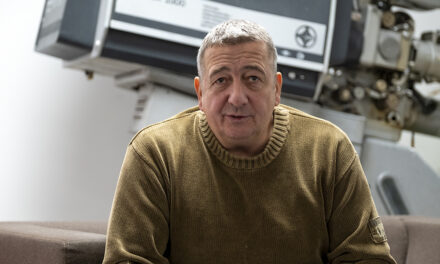The whole abomination started somewhere there, back then, in the 90s, and now the strangler fig is woven into everything. Complete societies.
I put it away deep down and haven't taken it out since. Some small pieces of paper with correct small letters.
One of the AVP (Alternative to Violence Project) trainings. The other is a multi-day "health education teacher" training. Today it all makes me smile. A modest text printed on yellow printer paper and the name and date still typed on the line with a typewriter. Three signatures without seal, without document and registration number.
This is a curiosity in itself. It is a reminder of what avid ignorance can do to waste time.
And if I rummage through the drawer a lot, two or three more sheets of paper with a similar format appear. As far as I remember, it was about basic training in narcology, assertiveness, or some other, not too deeply dissected, topic of maintaining mental health.
We wrote 1994-95 at that time. These new approaches to education, in the form of trainings and interactive courses, have been thrown in front of us one after another. It is excitingly different from the usual hierarchical and frontal forms of education. Because it was possible to express an opinion, talk about feelings, sir, in a learning situation.
Wow… We moved with the spirit. With the zeitgeist. Or with what?
Some of these trainings took place in higher education, and some were available as specialized courses alongside work. And there was great happiness, because until the engagement, they were all supported by some mysterious Hungarian benevolent soul who left for America. A kind grandfather. A person with a whole heart.
The sponsoring organization, the Soros Foundation, appeared on almost every piece of paper, or if you don't copy it, then on the study contracts.
We also knew who the excellent old man with a heart of gold is, who cares so much about the mental health of young Hungarians and the professional advancement of professionals!
He covered all our expenses. In other words, the costs of education, even if a modest self-cost did not arise as an attached passage in a study contract, on a separate page, which, despite the 100% support, had to be allocated to other arising teacher costs, strictly on a voluntary basis and in a precisely defined per capita quota.
And we all reached into our pockets, because right in front of our noses, everyone in the line did this, and in addition to the gratitude we felt for the generous old man, it was really appropriate to show loyalty to the instructors.
After that, the "multi-day" courses came, not only with educational technology innovations, but the topic also got a twist from time to time. Somehow, some kind of value-based lament crept into everything. Ethical analysis of situations that even in our small iron curtain-smelling world at the time caused at most blushing tension.
Because we were still very "backward" back then.
BNO was a disease code for sexual abuse and identity disorders, and young drug addicts can only be seen in the circles of the technocol rapidos punk subculture with stuck-together hair, as a rare living specimen.
In schools, the biggest problem was early smoking and we could also talk about AIDS as a disease that occurs on distant continents and affects only a narrow circle with special sexual habits.
We talked and "learned" about topics that were new to us and far from our everyday lives, which, in addition to their excitement, did not yet provide many practical handholds in our world. We could almost feel backward that we don't yet have anti-aggression programs and that on the streets of Szeged - I went to university here - the ambulance with its shrill siren does not rush to toxicology every minute with an unconscious young person.
One multi-day course followed another, and we, newly graduated professionals, slowly and thoroughly prepared ourselves for every life situation with which the probability of our encounter was still close to zero.
But we weren't disheartened that we wouldn't find a single LSD patient, morphine addict, or cocaine user in the country even with a magnifying glass. We learned very well how children can recognize drugs they have never seen before during educational classes at school. What are the toxic symptoms of amphetamine derivatives or what is a bad flash, and if you do encounter it one day, in another century, how to avoid it.
I think this is where my secondary shame started, when I realized in my first school education class that I had brought the image of a world into the consciousness of untouched little souls that they needed nothing but nothing.
We wrote 1995.
The first mobile phones were the size of a smaller suitcase, and if we saw a very well-to-do entrepreneur carrying a small box and yelling loudly into a normal-sized telephone receiver attached to it on the street, we didn't understand where the world had gone.
I remember the class, young teenagers with nice faces trying to hide their embarrassment when I started talking. I told them about love, about that all-overwhelming crazy feeling when we do one stupid thing after another, when our every sentence sounds like a whisper and even a look can lift our soul to the heavens. Or a missed smile to send you to hell. Because back then we shared likes with a smile.
I couldn't tell you about anything else.
I didn't feel for a moment that it was timely or reasonable to follow the content of the program and discuss the nature of sexual interest that differs from heterosexual habits. I didn't have the "professional and human flexibility" to explain the concepts of transgenderism or even zoophilia and necrophilia to young students. It didn't feel right.
I went home and put all my such papers in a file. Deep into a drawer. He never took it out again. Still.
Because what we have today is the bitter-sour fruit that has been ripening for a long time, with the astringent "crunchiness" of the girbegur branches. This fruit has been ripening in this "degenerate" state for at least twenty-five years. For twenty-five years, he has been sprinkled with some slowly trickling idea, dripped with icy calculation.
Has anyone seen a fig tree in documentaries about tropical regions?

Stock photo
The life of the strangler fig is very instructive.
Its small, seemingly defenseless seed falls to the ground, it has no particular significance. All of a sudden, at the base of the strong trees, a weak shoot shoots up. When it emerges from the ground, it immediately looks for support, with its fast-growing soft stem it stays close to the ground only until it reaches a tree trunk that provides adequate support. The viability of this seed is characterized by the fact that it does not die even if it gets stuck on a leaf. In this case, it grows roots downwards and stems upwards, thus reaching both the ground and the sunlight.
The plant serving as a support is defenseless against danger, it has no pattern to defend against an insignificant small plant, it develops undisturbed regardless of everything, its beautiful canopy is completed high up in the life-giving sunlight. It is not bothered by the small plants around its roots.
The problem is that the fig is going exactly where the tree is. That's why it wraps nicely around the strong wood with its slender tendrils. Slowly, day by day, the food-carrying stems close to the ground harden, becoming barely visible. The tree does not perceive much of this, because the fig branch does not absorb the nutrients from it. He doesn't tap his body fluids, he doesn't launch an attack.
Yet.
By this time, however, it is already weaving its own, increasingly tangled body through and through with its own folds, so it can happen that a battle starts between the soft and hard stems even within its coils. One fig branch strangles the other. Mercilessly. Even if they are fed by the same root.
Because the law is: the weak loses. It is suppressed or destroyed by the strong.
When the fig wraps around the trunk at a higher height, it begins to grow here and there into the bark, accompanied by its "painful" grip. Where it penetrates, it already absorbs the tree's nutrients. The tree suffers a lot from the set of wounds and strangulation that prevents the thickening of its bark, but in this state it is completely vulnerable and has no means of protection against the slowly creeping but now obviously parasitic danger. From now on, he is forced to endure.
Adding to the tree's troubles is the fact that new tendrils emerging from the ground, from the roots of the strangler fig, settle on its trunk, while they also continue to weave their own branches. For all this, the fig needs a lot of nutrients, which it takes from the tree, the soil and the trunk. The suffering tree is starving more and more.

Stock photo
When the fig reaches the canopy, it wraps around every part of it, and with its hardening, ever-thickening stems, deals a final blow to its helper with a deadly embrace. A dying tree will die in a short time. The consequence is clear: it rots over the years and the lifeless body collapses. It disappears as if it never existed.
Twenty-five years ago we let the tendrils thicken. Because we didn't think our own horn could do that.
But without supporting trees, the strangler fig is incapable of survival, and its self-destructive instincts do not help its long-term survival. If he has destroyed all the trees that nourish him and help him rise, then what is left?
Featured image source: Magyar Nemzet












